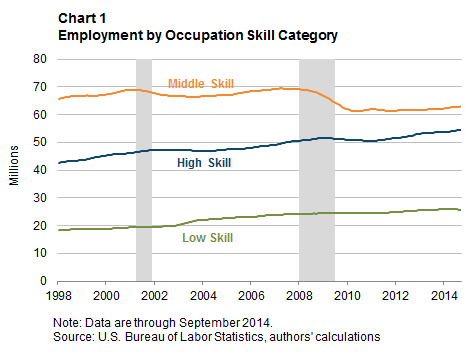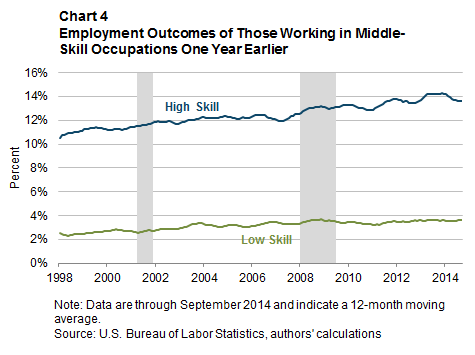ECON 101: On high, low, and middle-skilled workers
There is a great analysis on how workers holding jobs in different skill levels, (high, middle, and low) over at the Federal Reserve of Atlanta site that if you are as much of a labor market/macro workforce data geek as I am, I highly recommend reading.
The question the researchers set out to answer was based in this: We know that from a combination of the most recent economic recession and augmented by persistently advancing automation technology, that so-called 'middle' skilled workers were the most hard-hit group in the last downturn and recovery. What the researchers wanted to understand is what has or is happening to these displaced middle skill workers. Were they still out of work? Were they forced into lower skilled or service-type jobs? Or did they get the opportunity to move into more highly-skilled (and better paying) jobs?
Note - for the purposes of this analysis, 'middle-skilled' cconsists of office and administrative occupations; sales jobs; operators, fabricators, and laborers; and production, craft, and repair personnel (many of whom work in the manufacturing industry).
So let's take a look at the data - first the aggregate employment levels since 1998 for each skill category:

As of September 2014, the middle-skill employment level was still about 9 percent below the (pre-recession) 2007 level. In contrast, employment in low-skill occupations is 7 percent above pre-recession levels, and employment in high-skill occupations is about 8 percent higher than before the recession took hold. So the first assumption, that middle-skilled workers were hit harder by the recession/recovery than workers in the low and high skilled groups seems to have held up.
But what has been happening to these displaced middle-skilled workers? Surprisingly, many of them are/have moved into the high-skilled classification. About 83% of the displaced middle-skilled workers that are back employed are still in middle-skilled roles. But what about the other 17% of workers?
Let's take a look at the data:

The data shows that about 13% of the group has transitioned from a middle-skilled job into a high-skilled one. Only about 3.5% have been driven into a low-skilled role. This may seem like a small percentage of upward mobility, but it still seems significant to note.
If, as many economists expect, there continues to be further pressure and erosion of middle-skilled workers (which if you take another look at the first chart you will see still make up the largest category), it is important to the overall economy what happens to displaced middle-skilled workers. If they can transition into high-skilled roles, they see on average a 27% increase in compensation, as opposed to a 24% drop if they move into low-skilled roles.
While this data and these figures seem all kind of abstract and distant, then think about them this way: Think about your life and lifestyle with a 27% raise in compensation. Then think about it with a 24% pay cut. Pretty big difference, right?
And then take those scenarios, multiply them by 10 million or so, and now you have some feel for how important this issue is for the US economy.

 Steve
Steve
Reader Comments